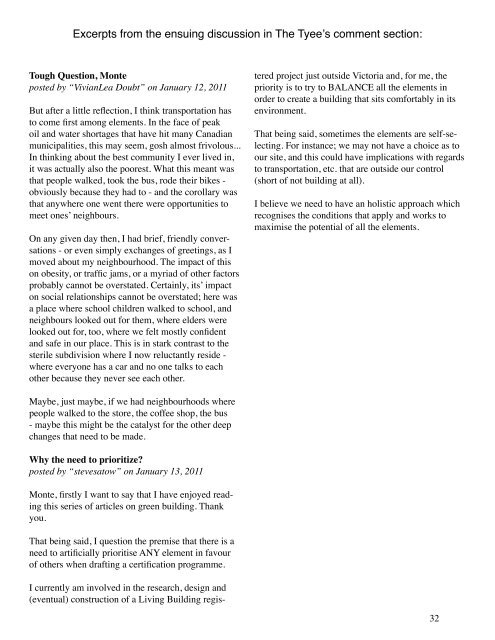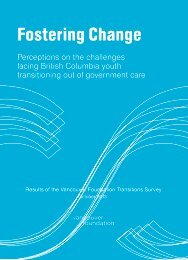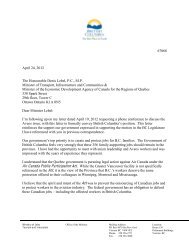from the ground up - The Tyee
from the ground up - The Tyee
from the ground up - The Tyee
Create successful ePaper yourself
Turn your PDF publications into a flip-book with our unique Google optimized e-Paper software.
Excerpts <strong>from</strong> <strong>the</strong> ensuing discussion in <strong>The</strong> <strong>Tyee</strong>’s comment section:Tough Question, Monteposted by “VivianLea Doubt” on January 12, 2011But after a little reflection, I think transportation hasto come first among elements. In <strong>the</strong> face of peakoil and water shortages that have hit many Canadianmunicipalities, this may seem, gosh almost frivolous...In thinking about <strong>the</strong> best community I ever lived in,it was actually also <strong>the</strong> poorest. What this meant wasthat people walked, took <strong>the</strong> bus, rode <strong>the</strong>ir bikes -obviously because <strong>the</strong>y had to - and <strong>the</strong> corollary wasthat anywhere one went <strong>the</strong>re were opportunities tomeet ones’ neighbours.On any given day <strong>the</strong>n, I had brief, friendly conversations- or even simply exchanges of greetings, as Imoved about my neighbourhood. <strong>The</strong> impact of thison obesity, or traffic jams, or a myriad of o<strong>the</strong>r factorsprobably cannot be overstated. Certainly, its’ impacton social relationships cannot be overstated; here wasa place where school children walked to school, andneighbours looked out for <strong>the</strong>m, where elders werelooked out for, too, where we felt mostly confidentand safe in our place. This is in stark contrast to <strong>the</strong>sterile subdivision where I now reluctantly reside -where everyone has a car and no one talks to eacho<strong>the</strong>r because <strong>the</strong>y never see each o<strong>the</strong>r.I currently am involved in <strong>the</strong> research, design and(eventual) construction of a Living Building registeredproject just outside Victoria and, for me, <strong>the</strong>priority is to try to BALANCE all <strong>the</strong> elements inorder to create a building that sits comfortably in itsenvironment.That being said, sometimes <strong>the</strong> elements are self-selecting.For instance; we may not have a choice as toour site, and this could have implications with regardsto transportation, etc. that are outside our control(short of not building at all).I believe we need to have an holistic approach whichrecognises <strong>the</strong> conditions that apply and works tomaximise <strong>the</strong> potential of all <strong>the</strong> elements.Maybe, just maybe, if we had neighbourhoods wherepeople walked to <strong>the</strong> store, <strong>the</strong> coffee shop, <strong>the</strong> bus- maybe this might be <strong>the</strong> catalyst for <strong>the</strong> o<strong>the</strong>r deepchanges that need to be made.Why <strong>the</strong> need to prioritize?posted by “stevesatow” on January 13, 2011Monte, firstly I want to say that I have enjoyed readingthis series of articles on green building. Thankyou.That being said, I question <strong>the</strong> premise that <strong>the</strong>re is aneed to artificially prioritise ANY element in favourof o<strong>the</strong>rs when drafting a certification programme.32








